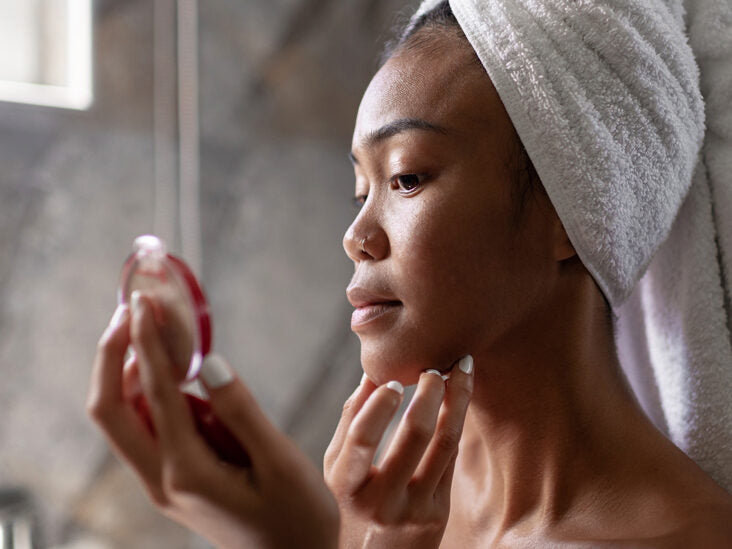
Trying out new skin care products or active ingredients could come with mixed emotions of excitement, anxiety, doubt and hope.
Especially if you are about to try something new that promises to take care of skin concerns you have been battling with for long.
Have you ever used a new product that made your skin actually looked worse rather than better? Maybe you started breaking out or experienced redness, stinging or got darker for the first week or so?
And it got so bad that your husband or friends start advising you to stop the products and then you threw the products away, assuming it just did not work well with your unique skin.
Does that sound familiar to you?
What if I told you that the tons of unopened and half-used beauty products worth hundreds of thousand of naira abandoned on your shelf are not entirely a waste?
What if I told you that it’s sometimes normal for skin to experience some uncomfortable reactions when a new product is first Introduced and that it is very likely that you have not just been giving products and your skin a long enough adjustment period.
In other words, the skin might get worse before it can get better. It is called the acclimation phase. If you have been unaware, then this post might be the most important thing you’ll read on the internet today and possibly a turning point on how you think about skincare.
Welcome to dermatological skincare, where things sometimes look worse before they look radiant.
Here’s everything you need to know about skincare acclimation.
Acclimation means to activate
The average cell turnover cycle is 30 to 45 days. Active Ingredients like Retinol, alpha hydroxy acids, and Salicylic acid accelerate cell turnover causing cells to slough off more quickly and new cells to come to the surface faster. This is the acclimation phase (also known as skin purging) during which your skin is getting used to a new product.
For retinol In particular, this process is known as Retinization.
The appearance of temporary flakiness or redness or breakouts that accompanies this process is a sign that your skin cells has being activated which marks the beginning of improved tone and smooth texture and once your skin finally acclimates you will see a much more noticeable result of the product you are using.
Is irritation part of Skincare?
Action brings about reaction and this is something you need to keep in mind when applying skincare.
Tingling, Mild redness. Slight dryness and flaking are normal. However, if your skin is stinging, if redness is more inflamed than rosy, if skin feels dry and tight, if the breakouts are popping out like crazy, you need to give your skin a chance to catch up.
Reduce usage to once every other day or even as low as once/twice a week and gradually ramp back up to daily use.
It’s not the product breaking you out but the process of cell turnover drawing out acne that were already forming under the surface without you knowing.
Are breakouts part of acclimation?
Accelerating the cell turnover cycle means pimples already forming under the skin get pulled to the surface faster. This purging can make it seem like you’re experiencing a sudden flare, but relax, it’s just the products doing their work. The good news is the breakout will be less severe, over quicker, and less likely to recur.
So overall, it is not a bad thing. In fact, it might actually be good for healthier skin all you have to do is keep using and push through.
Difference Between Breaking Out & Purging
The simplest way to tell if you’re breaking out or purging is the location of the acne.
If the acne forms in new areas where you don’t actually breakout, then it’s a breakout. If the acne appears in the same location you usually break out then its most likely purging.
How long does the skincare acclimation period last?
There is no definite answer. It depends on the product and your skin. If your skin is already conditioned to active ingredients and you’re just bumping up a level or trying a new product, acclimation may only last about 2 weeks or less. If you are new to active skincare, it could last between 4 to 6 weeks.
In general. It makes sense to use a product for at least one month before deciding if it’s working or not. One month is the average time it takes for a complete natural cycle of turnover. Stop it sooner and you won’t get a true picture of your results.
Does skin become immune to products after it becomes acclimated?
No. The fact that you’re not seeing the same reaction you did initially doesn’t mean that the product has stopped working. Instead, it means your skin has acclimated, and the benefits will continue to accrue.
Think about it. The reason your skin shows remarkable difference quickly when you first start using a good product is simply because you haven’t been feeding the skin the right nourishing and hydrating skincare it needs. Hence, a new product can seem to provide impressive results and wow you.
Once your skin is healthy the results are no longer obvious. However, that doesn’t mean the skincare products aren’t working.
You’re in maintenance mode where your skin is still increasingly but gradually accumulating benefits. So you don’t necessarily have to switch to another product. If you stop using that good product your skin might return to the pre-skincare condition. This can happen rapidly or take a while.
The only way to really appreciate the progress is to take before and after pictures, effectively reminding you of how good your skincare product is and if you are comfortable with the results you are getting, you can stay at this level to maintain your results. But if you want to push your results farther, it’s time to move up with higher concentrations.
In short, you don’t have to change a product that is working for you unless you feel it will be beneficial.
However, your skin changes as you age and it is always worth being aware of the changes and what products may offer more valuable assistance at every phase.
Is acclimation necessary for results?
Not all skincare products stimulate an acclimation process in your skin.
It mainly applies to products containing acids like salicylic acid or Alpha hydroxyl acids, retinol & sometimes Vitamin C. You may experience dryness, a feeling of tightness and notice a decrease in the quality of your skin when starting to use such products.
Understand that, skincare is an active therapy that triggers changes in the skin to improve tone and texture.
Think of the process like a workout. When you go to the gym and feel some soreness the next day, or the inside of your palm starts peeling after lifting weights, does that make you stop working out? Or do you recognize that as the sign that you are building muscle, getting stronger, and improving your health?
To achieve skincare results, stick to your regimen, push through the acclimation, and embrace that temporal discomfort for the big prize.
We know it’s not going to be easy, we understand how you feel.
That instead of glowing smoother skin, it’s as though the pimples are coming out more and everyone is taking notice and asking what’s happening.
Please don’t let it all get to you and make you quit prematurely. Give it a little time and you might just be glad you did.
How to manage acclimation
When you introduce your skin to new active ingredients or products, you should start slowly to avoid over stimulating your skin.
RECOMMENDED STARTING PLAN:
Week 1&2: Twice a week only at night
Week 3 & 4: 3 times a week at night
Week 5: Daily if need be.
If your skin feels irritated, reduce usage and gradually work up again to more frequent application.
How To Repurpose Skincare That Didn’t Work For You
1. Gift it
If a product doesn’t work for you, it might work for someone else! Ask if any of your family and friends want it and give it to them instead. Or, you guys can try swapping! Maybe they have a product that didn’t really work out either. Just make sure that all the products you want to gift or exchange are still within their shelf life.
2. Use For Body
If it doesn’t work for your face, try it on your body! Your skincare products won’t strip your body as much as your face. Making it a great way to repurpose skincare products! So, some cleansers can be used as a body wash. Moisturizers for example, can be used as hand/feet creams as well if they don’t work for your face. Most products are suitable for the body even if it wasn’t for the face. For serums and creams, use them for your hands and chest!
In summary, It takes between 2-8 weeks for the skin to become acclimated to new skincare products, and only then can you start to see results. Initially you may notice a negative effect on your skin, such as dryness, redness, pimples and spots. This is part of the skin’s natural purging process, and is completely normal. However, you are not meant to put up with continuous discomfort on your skin after 4 – 6 weeks - if this happens, stop using the products.


